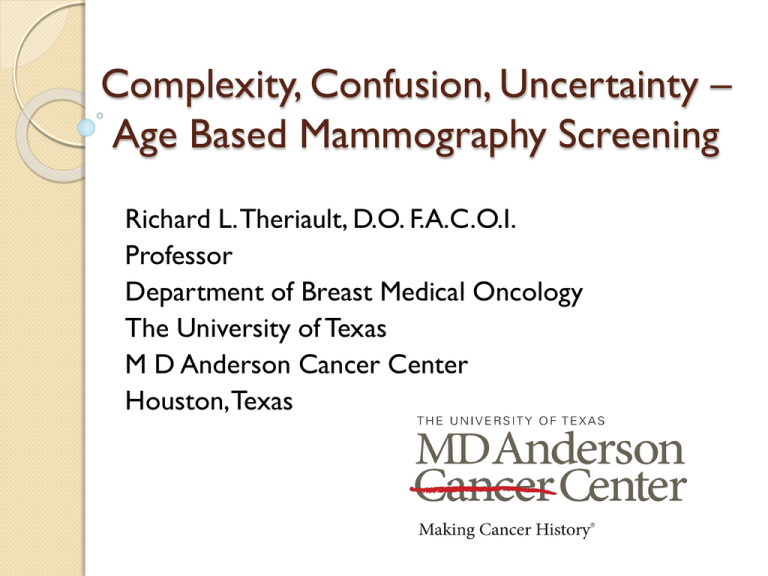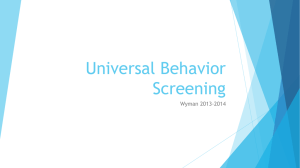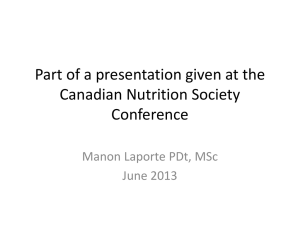
Complexity, Confusion, Uncertainty –
Age Based Mammography Screening
Richard L. Theriault, D.O. F.A.C.O.I.
Professor
Department of Breast Medical Oncology
The University of Texas
M D Anderson Cancer Center
Houston, Texas
Disclosures
I have no conflicts of interest in relation
to this presentation
I will not be discussing investigational use
of pharmaceuticals or devices
Objectives
Define screening
Consider populations who may benefit
from screening mammography
Understand the concepts of Number
Needed to Screen (NNS) and Number
Needed to Harm(NNH) in relation to
outcomes for mammography screening
Evidence Based Medicine
Requires the integration of best
research evidence with our clinical
expertise and our patient’s unique
values and circumstances
Evidence Based Medicine Strauss S. et al Third Edition
Screening for Breast Cancer with
Mammography - Outline
Rationale for screening
Population screening- who is at risk? Sex,
age, race, genetics, family history
Individual screening – who is at risk? Sex,
age, endocrine history
What is the evidence for mammography
screening?
◦
◦
◦
◦
Potential benefits
Potential harms
Who decides when and how to screen?
NNI, NNH
Clinical Case Presentation
A 42 year old woman requests advice
and counsel regarding screening for
cancer. She is concerned because her
friend has recently been diagnosed with
Stage III breast cancer and has been told
she has an “awful” prognosis. Do you
recommend screening studies for breast
cancer? What do you tell her about risks
and benefits of screening?
Screening
Early diagnosis of pre-symptomatic
disease among well individuals in the
general public
Goal – live longer or better
Requirements for Screening
Disease should be an important health
problem –approximately 200,000 new
breast cancer patients per annum USA
Disease should be detectable at an
asymptomatic stage (preclinical)
Early stage treatment should lead to
better patient outcomes
Screening test effective and accurate
Breast Cancer Sojourn Time and
Lead Time
Sojourn time (ST) - duration of time that
an occult breast cancer can be detected
before symptoms
Lead time (LT) – the amount of time
actually gained by screening before
symptoms
Breast Cancer Sojourn Time and
Lead Time
Mean sojourn time by age
◦
◦
◦
◦
2 - 2.4 years age 40-49
2.5 - 3.7 years age 50-59
3.5 - 4.2 years age 60-69
4 - 4.1 years age 70-74
◦ Theoretically screening should detect “early”
cancer, i.e. before clinically symptomatic
Breast Cancer Survival (5 year) in
Relation to Disease Stage
Stage 0 98% in situ
Stage I >90% tumor 2 cm or less
Stage II >85% lymph node positive(+)
Stage III >60% tumor >5 cm, lymph node +
Stage IV >20% systemic disease
Diagnosis at lower stage ought to lead to
better outcomes, therefore if screening leads
to early detection (lower stage) the
prognosis and survival should be better
Population Screening
Breast Cancer Incidence and Age
Age 40-49 - 1 in 69
Age 55-59 – 1in 42
Age 60-69 – 1in 29
Smith R A et al CA Cancer J Clin 2010;:99-119
Screening Recommendations and
Justification
Generally accepted that mammography
screening reduces breast cancer specific
mortality for women age 50 - 70
Little screening data over age 70
It has been recommended that annual
screening mammography begin at age 40
for women at “average risk” for breast
cancer
What are the data?
Population Screening –Healthy Women
Cochrane Review 2009– Screening for
Breast Cancer with Mammography
Randomized trials screening vs. no screening
Pub Med (through November 2008)
8 trials, 1 excluded due to bias
600,000 women
Trials (3) with adequate randomization – no reduction in
breast cancer mortality at 13 years
Trials (4) with suboptimal randomization significant mortality
reduction RR 0.75
RR for all 7 trials .81 (95% CI 0.74- 0.87)
Number of lumpectomies and mastectomies significantly
larger in the screened group RR 1.31
Nielsen G PC Cochrane Database of Systematic Reviews 2009, Issue 4; 2009
Population Screening –Healthy Women
Cochrane Review 2009– Screening for
Breast Cancer with Mammography
Review estimated 15% relative risk
reduction in overall breast cancer mortality
30% over diagnosis and over treatment
For every 200 women invited to screening
throughout 10 years one will have life
prolonged
10 healthy women will be diagnosed as
having breast cancer and be treated
unnecessarily
Population Screening –Healthy Women
Cochrane Review 2009– Screening for
Breast Cancer with Mammography
“It is not clear whether screening does
more harm than good”.
The Controversy
U.S. Preventive Services Task Force
Recommendations for Screening for Breast
Cancer
“The USPSTF recommends against routine
screening mammography in women age 40 -49
years”.
“The decision to start regular screening
mammography before the age of 50 years
should be an individual one and take into
account patient context, including the patient’s
values regarding specific benefits and harms”.
Annals Int Med 2009;151:716-726
USPSTF Issues
Lower sensitivity and specificity for
mammography in women age 40-49
Over diagnosis of breast cancer
False positive, false negatives, additional
imaging and biopsies
Radiation exposure – unknown risk related
to radiation dose over time
Procedure related pain
Anxiety, distress and psychological concerns
Annals Int Med 2009;151:716-726
USPSTF Review - Data sources
Randomized controlled trials
Cochrane Central Register of Controlled Trials
Cochrane Database of Systematic Reviews
Meta Analysis - 8 randomized controlled trials
End point - breast cancer specific mortality
Annals Int Med 2009;151:716-726
Mammography Sensitivity and
Specificity
Sensitivity 77-95% - proportion of people
with the target disorder who have a
positive test result
Specificity 94-97% -proportion of people
without the target disorder who have a
negative result
Annals Int Med 2009;151:716-726
How good is Mammography?
Performance measures for 3,603,832 Screening
Mammograms
Sensitivity (%)b
Age
Specificity (%)c
PPV1 (%)
40-44
70.8
89.8
1.5
45-49
74.3
89.8
2.3
50-54
78.4
90.9
3.3
55-59
81.6
91.5
4.6
60-64
80.0
91.9
5.4
65-69
82.5
92.4
6.3
70-74
82.9
93.1
7.9
•From
Diseases of the Breast Fourth Edition p94
Controversy – Interpreting the
Evidence
USPSTF
◦ Mortality reduction estimates with screening
mammography
15% age 39-49
14% age 50-59
32% age 60-69
No effect age70-74
How much mortality benefit is enough to
warrant “routine” screening??
Ann Int Med 2009;151:727-737
Cancers Detected per USPSTF
Report
Age 40-49
Age 50-59
Age 60-69
Age 70-79
Age 80-89
- 1.8 invasive, 0.8 non-invasive
- 3.4 invasive, 1.3 non-invasive
- 5.0 invasive, 1.5 non-invasive
- 6.5 invasive, 1.4 non-invasive
- 7.0 invasive, 1.5 non-invasive
Ann Int Med 2009;151:727-737
USPSTF - Yield per Screening Round
Number of mammograms per case of
invasive breast cancer
◦
◦
◦
◦
◦
Age 40-49
Age 50-59
Age 60-69
Age 70-79
Age 80-89
- 556
- 294
- 200
-154
– 143
◦ Ann Int Med 2009;151:727-737
USPSTF Number of Additional
Imaging Studies and Biopsy(ies) By
Age at Screening
Age 40-49
Age 50-59
Age 60-69
Age 70-79
Age 80-89
- 47, 5
- 22, 3
- 14, 2
- 10, 2
- 8, 1.5
Ann Int Med 2009;151:727-737
Clinical Context
Age 39-49 - Number needed to invite (NNI) to
screen 1904, to prevent one breast cancer
death
Age 50-59 – NNI 1339
Conclusion – “Women age 40-49 experience
the highest rate of additional imaging whereas
their biopsy rate is lower than that for older
women”.
“Mammography screening at any age is a
tradeoff of a continuum of benefits and harms”.
Ann Int Med 2009;151:727-737
Another Perspective - Critique of
the USPSTF Recommendations
No scientific basis for age 50 thresh hold
Lowest possible mortality benefit used in breast cancer specific
mortality calculations
Computer models favored over direct data
Decrease in deaths mostly due to screening, not therapy
Breast cancer not trivial in women in their 40’s
No data to support only screening high-risk women
Annual screening from age 40 saves the most lives
Screening anxiety is not equal to death from breast cancer
All women should be informed of risks and benefits
Kopans D Radiology 2010;256 15-20
What to do?
Cancer Risk Assessment
An individualized evaluation of a patient’s risk for
cancer based on history and physical examination
◦
◦
◦
◦
◦
◦
◦
◦
◦
◦
Examination of breasts and nodal basins
Patient age
Family history – three generations preferred
Race/ethnicity
Endocrine history – menarche, pregnancies, exogenous
hormone exposure
Prior biopsy – ADH, ALH
Diet
Physical activity
Environmental exposures - ETOH, XRT
Personal cancer history – Hodgkin’s Disease, XRT
Clinical Case Presentation
42 y/o Caucasian woman
Family history – 2 first degree relatives
with breast cancer, age 45 and 75
Nulliparous
One prior breast biopsy – benign
“moderate” ethanol intake
Is this person average risk?
Should she have screening?
Cancer Risk Assessment Tools
◦ Gail model (www.cancer.gov/bcrisktool)
◦ Claus Model
◦ BRCAPRO for BRCA 1 and 2
assessment
Screening Recommendations Society of Breast Imaging and ACR
Annual Mammographic screening from age 40
Women at increased risk – BRCA mutations annually starting at age 30
Women with histories of mantle irradiation –
annually beginning 8 years after radiation but not
before age 25
Women with mothers or sisters with premenopausal breast cancer –beginning age 30 but
not before age 25, or 10 years earlier than the
age of diagnosis of the youngest affected relative
whichever is later
Lee C H et al J Am Coll Radiol 2010;7:18-27
American Cancer Society
Recommendations for Breast cancer
Screening
Breast self examination – beginning in early
20’s (no data on risk reduction)
Clinical Breast examination – beginning in
20-30’s and every three years (no data on
risk reduction)
Mammography – annually beginning age 40
Smith R A et al CA A Cancer J Clin 2010;99-119
Breast Cancer Screening with
Mammography - Conclusions
The mammography screening
recommendations of the United States
Preventive Services Task Force, American
Cancer Society and the American College
of Radiology/Society of Breast Imaging all
differ based on reviews and judgments of
the same evidence base
Breast Cancer Screening with
Mammography - Conclusions
Evidence review of the Cochrane Systematic Review
suggests the risks of population screening may
outweigh the benefits
USPSTF review concludes there is a 15% breast
cancer specific mortality relative risk reduction with
screening age 50-70
Evidence review from the USPSTF suggests potential
harms may outweigh the risks of “routine annual
screening” in women age 40-49
Others examining the same “evidence” contend that
there is no justification for excluding women age 4049 from screening programs
Breast Cancer Screening with
Mammography - Conclusions
For women >70-75 years there are too few
data to make an evidence based
recommendation and screening
recommendations must be individualized
All agree that “best research evidence“ is
lacking – poor study conduct, poor
randomizations, different study designs,
objectives, populations, end points, relative
risk reductions reported
Breast Cancer Screening with
Mammography - Conclusions
All agree “best interests” of the patient
are the primary consideration
All agree the patient’s values and
preferences must be considered
All agree that the clinician must engage
the patient in discussion of the relative
risks, harms and burdens of testing in
relation to individual benefit expected
Clinical Case Presentation
42 year old women with anxiety regarding
her friend’s breast cancer diagnosis
2 first degree relatives with breast cancer
Nulliparous
Prior breast biopsy
Risk assessment >1.67 %
SCREEN





